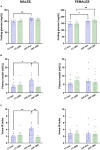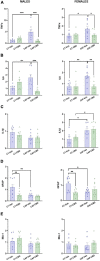Cannabidiol treatment improves metabolic profile and decreases hypothalamic inflammation caused by maternal obesity
- PMID: 36969815
- PMCID: PMC10033544
- DOI: 10.3389/fnut.2023.1150189
Cannabidiol treatment improves metabolic profile and decreases hypothalamic inflammation caused by maternal obesity
Abstract
Introduction: The implications of maternal overnutrition on offspring metabolic and neuroimmune development are well-known. Increasing evidence now suggests that maternal obesity and poor dietary habits during pregnancy and lactation can increase the risk of central and peripheral metabolic dysregulation in the offspring, but the mechanisms are not sufficiently established. Furthermore, despite many studies addressing preventive measures targeted at the mother, very few propose practical approaches to treat the damages when they are already installed.
Methods: Here we investigated the potential of cannabidiol (CBD) treatment to attenuate the effects of maternal obesity induced by a cafeteria diet on hypothalamic inflammation and the peripheral metabolic profile of the offspring in Wistar rats.
Results: We have observed that maternal obesity induced a range of metabolic imbalances in the offspring in a sex-dependant manner, with higher deposition of visceral white adipose tissue, increased plasma fasting glucose and lipopolysaccharides (LPS) levels in both sexes, but the increase in serum cholesterol and triglycerides only occurred in females, while the increase in plasma insulin and the homeostatic model assessment index (HOMA-IR) was only observed in male offspring. We also found an overexpression of the pro-inflammatory cytokines tumor necrosis factor-alpha (TNFα), interleukin (IL) 6, and interleukin (IL) 1β in the hypothalamus, a trademark of neuroinflammation. Interestingly, the expression of GFAP, a marker for astrogliosis, was reduced in the offspring of obese mothers, indicating an adaptive mechanism to in utero neuroinflammation. Treatment with 50 mg/kg CBD oil by oral gavage was able to reduce white adipose tissue and revert insulin resistance in males, reduce plasma triglycerides in females, and attenuate plasma LPS levels and overexpression of TNFα and IL6 in the hypothalamus of both sexes.
Discussion: Together, these results indicate an intricate interplay between peripheral and central counterparts in both the pathogenicity of maternal obesity and the therapeutic effects of CBD. In this context, the impairment of internal hypothalamic circuitry caused by neuroinflammation runs in tandem with the disruptions of important metabolic processes, which can be attenuated by CBD treatment in both ends.
Keywords: cannabidiol; hypothalamus; insulin resistance; maternal obesity; neuroinflammation.
Copyright © 2023 Rodrigues, Jantsch, Fraga, Dias, Eller, De Oliveira, Giovenardi and Guedes.
Conflict of interest statement
The authors declare that the research was conducted in the absence of any commercial or financial relationships that could be construed as a potential conflict of interest.
Figures







References
LinkOut - more resources
Full Text Sources
Miscellaneous

